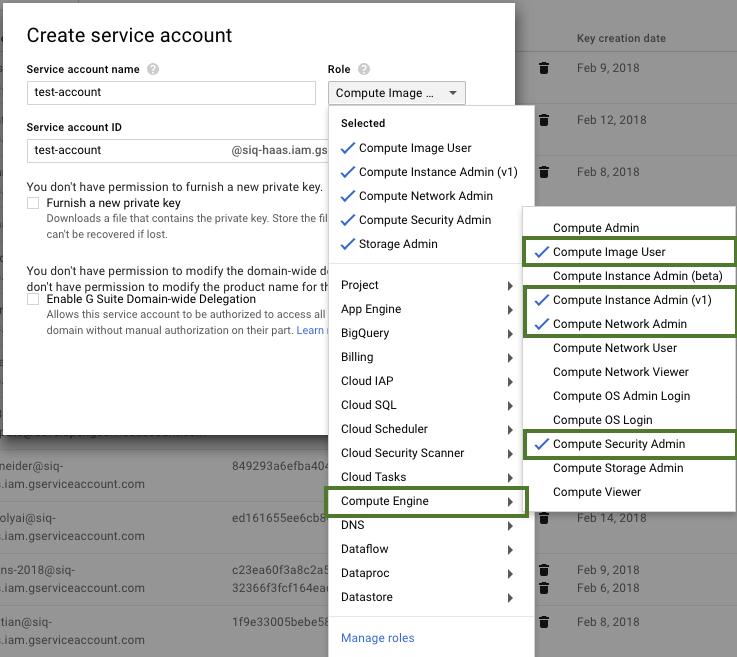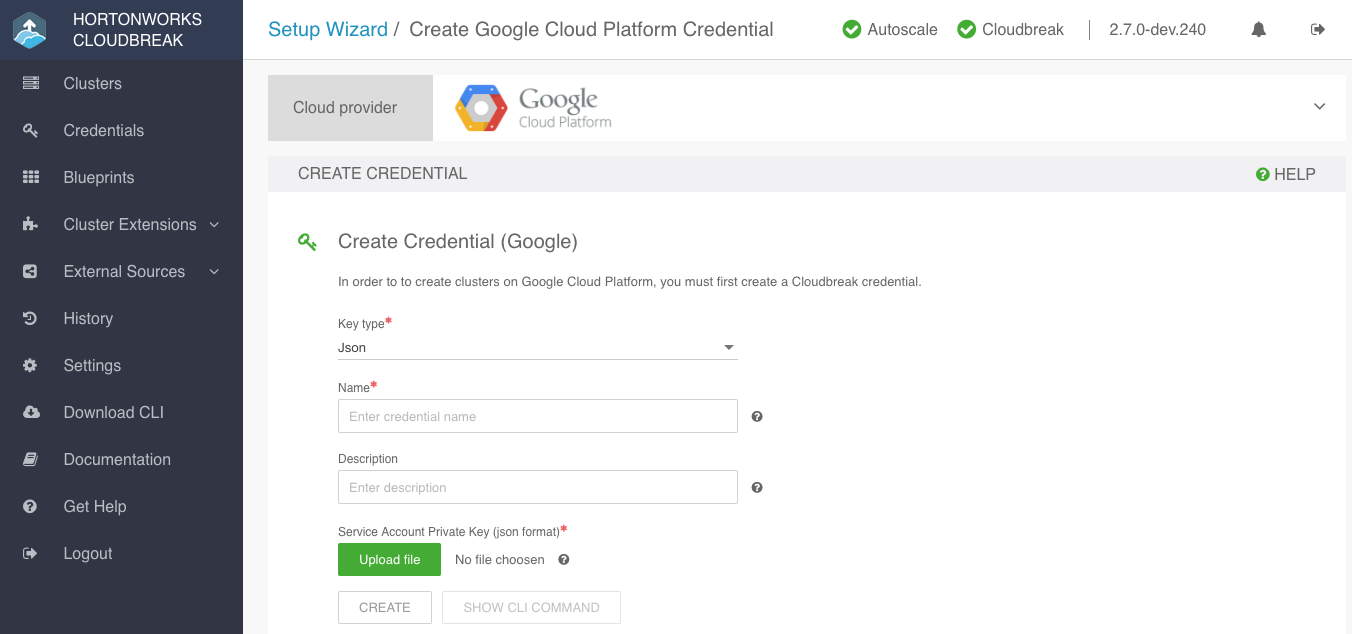Prerequisites on GCP
Before launching Cloudbreak on GCP, you must meet the following prerequisites.
GCP Account
In order to launch Cloudbreak on GCP, you must log in to your GCP account. If you don't have an account, you can create one at https://console.cloud.google.com.
Once you log in to your GCP account, you must either create a project or use an existing project.
Service Account
In order to launch clusters on GCP via Cloudbreak, you must have a service account that Cloudbreak can use to create resources. In addition, you must also have a JSON key associated with the account.
The service account must have the following roles are enabled:
- Compute Engine > Compute Image User
- Compute Engine > Compute Instance Admin (v1)
- Compute Engine > Compute Network Admin
- Compute Engine > Compute Security Admin
- Storage > Storage Admin
A user with an "Owner" role can assign roles to new and existing service accounts from IAM & admin > Service accounts, as presented in the following screenshots:
For more information on creating a service account and generating a JSON key, refer to GCP documentation.
Related links
Service account credentials (External)
SSH Key Pair
Generate a new SSH key pair or use an existing SSH key pair. You will be required to provide it when launching the VM.
Virtual Network
You must have a virtual network configured on your cloud provider.
Security Group
Ports 22 (SSH), 80 (HTTPS), and 443 (HTTPS) must be open on the security group
Region and Zone
Decide in which region and zone you would like to launch Cloudbreak. You can launch Cloudbreak and provision your clusters in all regions supported by GCP.
Clusters created via Cloudbreak can be in the same or different region as Cloudbreak; when you launch a cluster, you select the region in which to launch it.
Related links
Regions and zones (External)
Launching Cloudbreak on GCP
These steps describe how to launch Cloudbreak on GCP for production. Before launching Cloudbreak on Google Cloud, review and meet the prerequisites. Next, follow the steps below.
VM Requirements
To launch the Cloudbreak deployer and install the Cloudbreak application, you must have an existing VM.
System Requirements
Your system must meet the following requirements:
- Minimum VM requirements: 16GB RAM, 40GB disk, 4 cores
- Supported operating systems: RHEL, CentOS, and Oracle Linux 7 (64-bit)
You can install Cloudbreak on Mac OS X for evaluation purposes only. Mac OS X is not supported for a production deployment of Cloudbreak.
Root Access
Every command must be executed as root. In order to get root privileges execute:
sudo -i
System Updates
Ensure that your system is up-to-date by executing:
yum -y update
Reboot it if necessary.
Install iptables
Perform these steps to install and configure iptables.
Steps
-
Install iptables-services:
yum -y install net-tools ntp wget lsof unzip tar iptables-services systemctl enable ntpd && systemctl start ntpd systemctl disable firewalld && systemctl stop firewalld
Without iptables-services installed the
iptables savecommand will not be available. -
Configure permissive iptables on your machine:
iptables --flush INPUT && \ iptables --flush FORWARD && \ service iptables save
Disable SELINUX
Perform these steps to disable SELINUX.
Steps
-
Disable SELINUX:
setenforce 0 sed -i 's/SELINUX=enforcing/SELINUX=disabled/g' /etc/selinux/config
-
Run the following command to ensure that SELinux is not turned on afterwards:
getenforce
-
The command should return "Disabled".
Install Docker
Perform these steps to install Docker. The minimum Docker version is 1.13.1. If you are using an older image that comes with an older Docker version, upgrade Docker to 1.13.1 or newer.
Steps
-
Install Docker service:
yum install -y docker systemctl start docker systemctl enable docker
-
Check the Docker Logging Driver configuration:
docker info | grep "Logging Driver"
-
If it is set to
Logging Driver: journald, you must set it to "json-file" instead. To do that:-
Open the
dockerfile for editing:vi /etc/sysconfig/docker
-
Edit the following part of the file so that it looks like below (showing
log-driver=json-file):# Modify these options if you want to change the way the docker daemon runs OPTIONS='--selinux-enabled --log-driver=json-file --signature-verification=false'
-
Restart Docker:
systemctl restart docker systemctl status docker
-
Install Cloudbreak on a VM
Install Cloudbreak using the following steps.
Steps
-
Install the Cloudbreak deployer and unzip the platform-specific single binary to your PATH. For example:
yum -y install unzip tar curl -Ls public-repo-1.hortonworks.com/HDP/cloudbreak/cloudbreak-deployer_2.4.3_$(uname)_x86_64.tgz | sudo tar -xz -C /bin cbd cbd --version
Once the Cloudbreak deployer is installed, you can set up the Cloudbreak application.
-
Create a Cloudbreak deployment directory and navigate to it:
mkdir cloudbreak-deployment cd cloudbreak-deployment
-
In the directory, create a file called
Profilewith the following content:export UAA_DEFAULT_SECRET=MY-SECRET export UAA_DEFAULT_USER_PW=MY-PASSWORD export UAA_DEFAULT_USER_EMAIL=MY-EMAIL export PUBLIC_IP=MY_VM_IP
For example:
export UAA_DEFAULT_SECRET=MySecret123 export UAA_DEFAULT_USER_PW=MySecurePassword123 export UAA_DEFAULT_USER_EMAIL=dbialek@hortonworks.com export PUBLIC_IP=172.26.231.100
You will need to provide the email and password when logging in to the Cloudbreak web UI and when using the Cloudbreak CLI. The secret will be used by Cloudbreak for authentication.
You should set the CLOUDBREAK_SMTP_SENDER_USERNAME variable to the username you use to authenticate to your SMTP server. You should set the CLOUDBREAK_SMTP_SENDER_PASSWORD variable to the password you use to authenticate to your SMTP server.
-
Generate configurations by executing:
rm *.yml cbd generate
The cbd start command includes the cbd generate command which applies the following steps:
- Creates the
docker-compose.ymlfile, which describes the configuration of all the Docker containers required for the Cloudbreak deployment. - Creates the
uaa.ymlfile, which holds the configuration of the identity server used to authenticate users with Cloudbreak.
- Creates the
-
Start the Cloudbreak application by using the following commands:
cbd pull-parallel cbd start
This will start the Docker containers and initialize the application. The first time you start the Cloudbreak app, the process will take longer than usual due to the download of all the necessary docker images.
If you encounter errors during
cbd start, refer to Toubleshooting. -
Next, check Cloudbreak application logs:
cbd logs cloudbreak
You should see a message like this in the log:
Started CloudbreakApplication in 36.823 seconds.Cloudbreak normally takes less than a minute to start.
Related links
Toubleshooting
Access Cloudbreak web UI
Log in to the Cloudbreak UI using the following steps.
Steps
-
You can log into the Cloudbreak application at
https://IP_Address. For examplehttps://34.212.141.253. You may usecbd startto obtain the login information. Alternatively, you can obtain the VM's IP address from your cloud provider console. -
Confirm the security exception to proceed to the Cloudbreak web UI.
The first time you access Cloudbreak UI, Cloudbreak will automatically generate a self-signed certificate, due to which your browser will warn you about an untrusted connection and will ask you to confirm a security exception.
Browser Steps Firefox Click Advanced > Click Add Exception... > Click Confirm Security Exception Safari Click Continue Chrome Click Advanced > Click Proceed... -
The login page is displayed:
-
Log in to the Cloudbreak web UI using the credentials that you configured in your
Profilefile:- The username is the
UAA_DEFAULT_USER_EMAIL - The password is the
UAA_DEFAULT_USER_PW
- The username is the
-
Upon a successful login, you are redirected to the dashboard:
Configure external Cloudbreak database
By default, Cloudbreak uses an embedded PostgreSQL database to persist data related to Cloudbreak configuration, setup, and so on. For a production Cloudbreak deployment, you must configure an external database.
Related links
Configure an external database
Create Cloudbreak Credential
Cloudbreak works by connecting your GCP account through this credential, and then uses it to create resources on your behalf. Before you can start provisioning cluster using Cloudbreak, you must create a Cloudbreak credential.
Prerequisites
In order to launch clusters on GCP via Cloudbreak, you must have a service account that Cloudbreak can use to create resources. If you do not have one, refer to Prerequisites: Service account.
Steps
-
In the Cloudbreak web UI, select Credentials from the navigation pane.
-
Click Create Credential.
-
Under Cloud provider, select "Google Cloud Platform":
-
Provide the following information:
Parameter Description Key type Select JSON or P12. Since activating service accounts with P12 private keys has been deprecated in the Cloud SDK, we recommend using JSON. Name Enter a name for your credential. Description (Optional) Enter a description. Project Id (Only required for P12 key type) Enter the project ID. You can obtain it from your GCP account by clicking on the name of your project at the top of the page and copying the ID. Service Account Email Address (Only required for P12 key type) "Service account ID" value for your service account created in prerequisites. You can find it on GCP at IAM & Admin > Service accounts. Service Account Private Key Upload the key that you created in the prerequisites when creating a service account. -
Click Create.
-
Your credential should now be displayed in the Credentials pane.
Congratulations! You have successfully launched Cloudbreak and created a Cloudbreak credential. Now you can use Cloudbreak to create clusters.




